Jan's Working with Presentations
Basics: Interface: Ribbon
The ribbon is part of what Microsoft calls the Fluent User Interface. They have tried to make the commands that are used the most often easier to get to by grouping them on several tabs. There are many more commands that are not on any tab. Anything that is not already on the ribbon can be added to the Quick Access Toolbar at the top left of the PowerPoint window. In PowerPoint 2010 and 2013, you can also create your own tab or add your own tab group to an existing tab.


Home ribbon tab
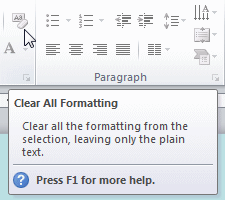 Screen Tip:
Screen Tip:
Happily,
when your mouse is over a ribbon control, a screen tip pops up to quickly let you
know what the control does. You don't need a chart to figure out what that button is
for!
Context-sensitive tabs:
There are more ribbon tabs than those
that show when PowerPoint starts. Other tabs appear when they are needed,
usually when an object is selected, like a chart, drawing, picture, or table.
That makes sense! Some objects have a group of ribbon tabs.
For example, Chart Tools is a group of three tabs: Design, Layout, Format but Picture Tools has just one tab, Format
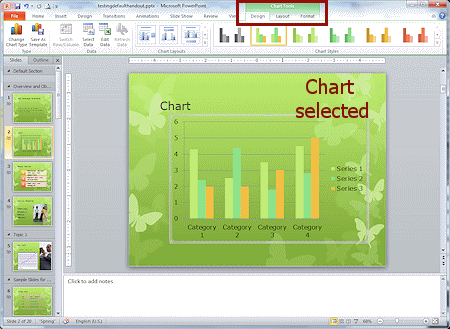
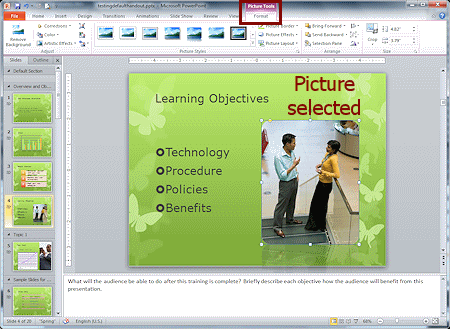
The active tab on the ribbon has a white background with a border. Context tabs have an additional colored tab up higher. In these lessons, the names of all tabs will be formatted like: Home
Inactive tabs don't have a tab shape around the name. The name just sits there on the background of the ribbon like a menu.
![]() PowerPoint 2007: Office button
PowerPoint 2007: Office button ![]()
At the far left of the ribbon in PowerPoint 2007 is ![]() the Office button. It opens a list of commands, similar to the File menu in previous versions of
PowerPoint. The list of Recent Documents
can be much longer than in previous versions. Documents you open regularly can be pinned
to the list so that they are always quickly available.
the Office button. It opens a list of commands, similar to the File menu in previous versions of
PowerPoint. The list of Recent Documents
can be much longer than in previous versions. Documents you open regularly can be pinned
to the list so that they are always quickly available.
![]()
![]()
![]() PowerPoint 2010, 2013, 2016:
File tab
PowerPoint 2010, 2013, 2016:
File tab ![]()
At the far left of the ribbon in
PowerPoint
2010, 2013, and 2016 is the File tab, which is always colored, even
when that tab is not open. A bit confusing since other tabs don't work that way.
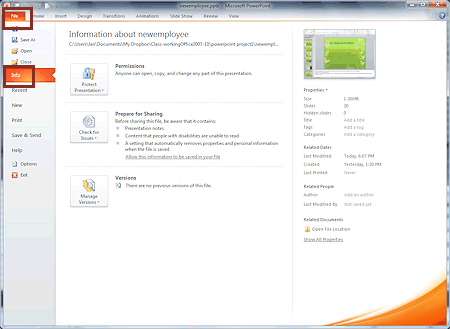 This tab opens the Backstage View, instead of a ribbon tab. This view takes up the whole window, which hides
your presentation. At the left is a list of the commands that apply to the document as
a whole, such as Open, Save, Save As, Print, Options, and Close. You
cannot edit the document in this view, even in the preview that is part of
the Print page.
This tab opens the Backstage View, instead of a ribbon tab. This view takes up the whole window, which hides
your presentation. At the left is a list of the commands that apply to the document as
a whole, such as Open, Save, Save As, Print, Options, and Close. You
cannot edit the document in this view, even in the preview that is part of
the Print page.
Clicking one of the commands at the left changes what you see at the right.
The Info pane has two panels. The far right panel shows properties of the current presentation. The center panel has some information and some buttons to open further menus.
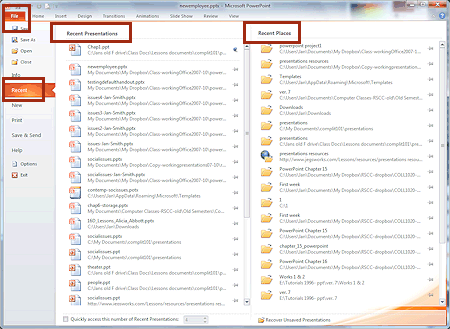 The Recent page in PowerPoint 2010 (which is not shown in 2013 or 2016) has two panels - a list of recent presentations and a list
of recent places from which you opened a presentation. This can even include
online locations. Very helpful!
The Recent page in PowerPoint 2010 (which is not shown in 2013 or 2016) has two panels - a list of recent presentations and a list
of recent places from which you opened a presentation. This can even include
online locations. Very helpful!
For PowerPoint 2013 and 2016 the recently viewed presentations are listed when you choose Open.
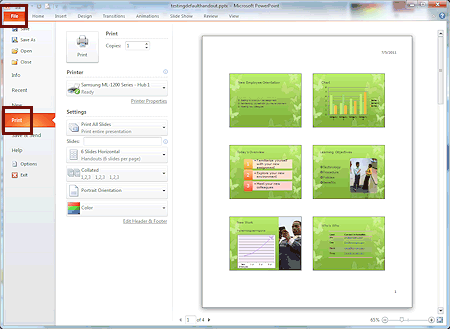 The Print page includes a Print Preview and all of the settings that affect how
and what is printed, like margins, number of copies, which pages, what size
paper. These were scattered in several different places before Office 2010.
The Print page includes a Print Preview and all of the settings that affect how
and what is printed, like margins, number of copies, which pages, what size
paper. These were scattered in several different places before Office 2010.
Customizing the Ribbon
You can't change much about the existing ribbon tabs unless you can write programming code. That's no help for most of us! But there are some features to help those who have an itch to modify the interface.
What you can't do:
- You cannot add commands or groups of commands to the existing tabs.
- You cannot rearrange icons or change the image for an icon on the existing tabs.
- You cannot move the ribbon from the top of the window.
- You cannot switch back to the old toolbars and menus interface.
What you can do:
- You can add commands to the Quick Access Toolbar



That's what it's for! (More on how to do this below.) -
You can minimize the ribbon to hide it.
- Minimize Ribbon: Right click on a tab and select Minimize the Ribbon or Collapse the Ribbon (PowerPoint 2013, 2016).

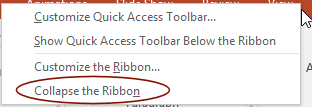
Only the tab titles will show. All of the buttons and palettes are hidden. - Show a ribbon tab again temporarily: Click on a tab name.
When you click on something in the ribbon, the ribbon will minimize again immediately.  Show Ribbon all the time: Right click a tab again and click on Minimize ribbon again to uncheck that command.
Show Ribbon all the time: Right click a tab again and click on Minimize ribbon again to uncheck that command.

Ribbon minimized. Only the tab names show.
![]()
![]()
![]() PowerPoint
2010, 2013, 2016: New features for the ribbon
PowerPoint
2010, 2013, 2016: New features for the ribbon
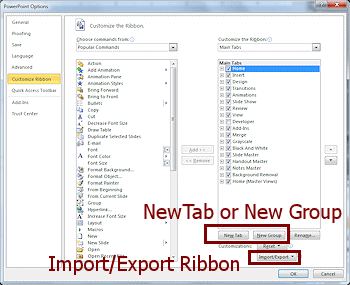 Add a Custom tab or group: Right
click a tab and choose Customize the Ribbon.
Add a Custom tab or group: Right
click a tab and choose Customize the Ribbon.
A dialog opens where you can add a custom tab to the ribbon or a custom group to one of the default tabs. You still cannot change the default ribbon layout.
- Import/export ribbon: You can transport your custom
tab or group to a different computer and import it into PowerPoint 2010, 2013, or 2016.
Collapsing Ribbon Groups
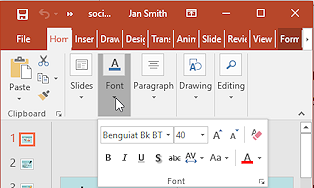 If the window is too narrow to show all of the ribbon items,
tab groups on
the ribbon will collapse. Some of the large buttons may go to a small size.
If the window is too narrow to show all of the ribbon items,
tab groups on
the ribbon will collapse. Some of the large buttons may go to a small size.
This illustration shows all of the groups on the Home tab as collapsed for a very narrow window. Clicking the arrow at the bottom of the group opens a palette that shows what was hidden.
The Font group is opened in the illustration.
I don't think you really want to work with a window this narrow!
Just don't be surprised when you don't see what you are looking for on the ribbon in a window that is too narrow to show everything. You've been warned!
Quick Access Toolbar
The Quick Access Toolbar is at the top left of the window.
![]()
![]()
![]()
By default it holds at least three icons:
| |
||
| Save | Undo | Redo |
PowerPoint 2013 and 2016 have two extra default commands: ![]()
![]() Start From Beginning and
Start From Beginning and ![]()
![]() Touch/Mouse Mode. In Touch mode PowerPoint makes some things larger with more space between to make it easier to select with a touch screen or touchpad.
Touch/Mouse Mode. In Touch mode PowerPoint makes some things larger with more space between to make it easier to select with a touch screen or touchpad.
For all versions you can also add other commands to the Quick Access Toolbar from the More list, like' Print Preview and Print', or commands from the Customize Quick Access Toolbar dialog.
Undo/Redo/Repeat:
PowerPoint remembers the last 20 actions by default. That's not as many as it sounds like! You can increase that number [Recommended!] in the PowerPoint Options dialog in the Advanced section to a maximum of 150.
The Undo button can back you up to a good spot when you get
carried away. If you back up too far, the Redo button will go forward through the actions you just undid. Some actions can be repeated. The Redo button ![]()
![]()
![]() will change
to the Repeat button
will change
to the Repeat button ![]()
![]()
![]() in that case. That is useful
when you want to apply the same command in several different locations.
in that case. That is useful
when you want to apply the same command in several different locations.
More Commands:
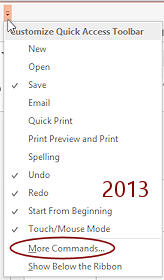
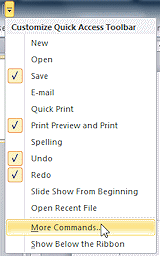 The More arrow at the right end
The More arrow at the right end ![]()
![]()
![]() of the Quick Access Toolbar opens a drop list of commands that are often
added to the
Quick Access Toolbar. A check mark in the list shows that the item is
already on the bar. Just click on a command to add it.
of the Quick Access Toolbar opens a drop list of commands that are often
added to the
Quick Access Toolbar. A check mark in the list shows that the item is
already on the bar. Just click on a command to add it.
You can also add any other command that PowerPoint knows using More Commands... . You would want
to choose commands for things that you do often, but which are not on the
tab that is usually open when you need that command.
How to add commands to Quick Access Toolbar:
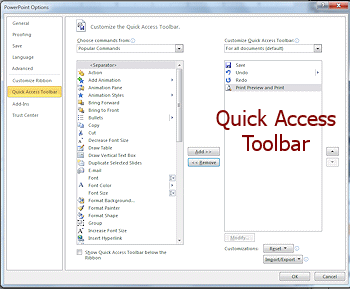 Right click a tab and click on
Customize Quick Access Toolbar or click the More button and then More Commands...
Right click a tab and click on
Customize Quick Access Toolbar or click the More button and then More Commands...
The dialog opens with a list of Popular Commands on the left and on the right is a list of what is already on the toolbar.- Click on a command and then on the Add>> button.
Arrows at the right let you change the order of the buttons on the toolbar. - If the Popular Commands list does not have the command you want, change the list to All Commands or Commands not on the Ribbon.
Example: What I added to the Quick Access bar and Why
I added a button for Print Preview ![]()
![]()
![]() .
In PowerPoint 2007 this replaces 3 actions: Office button >
Print > Print Preview. In PowerPoint 2010, 2013, and 2016 this replaces 2 actions: File > Print. I avoid the confusingly similar Print button, which immediately starts printing with the last used settings. Who can remember what those were?
.
In PowerPoint 2007 this replaces 3 actions: Office button >
Print > Print Preview. In PowerPoint 2010, 2013, and 2016 this replaces 2 actions: File > Print. I avoid the confusingly similar Print button, which immediately starts printing with the last used settings. Who can remember what those were?
You might find other commands
useful to have on the Quick Access Toolbar, also. For example, when I am
writing slides for an algebra lesson, I find it useful to have a button for
superscript ![]()
![]()
![]() on the Quick Access Toolbar
so I can write equations like x2 + y2 = 36. That button is on the Word Home ribbon tab by default but not in PowerPoint.
on the Quick Access Toolbar
so I can write equations like x2 + y2 = 36. That button is on the Word Home ribbon tab by default but not in PowerPoint.
Feel free to add any commands that you find helpful.
